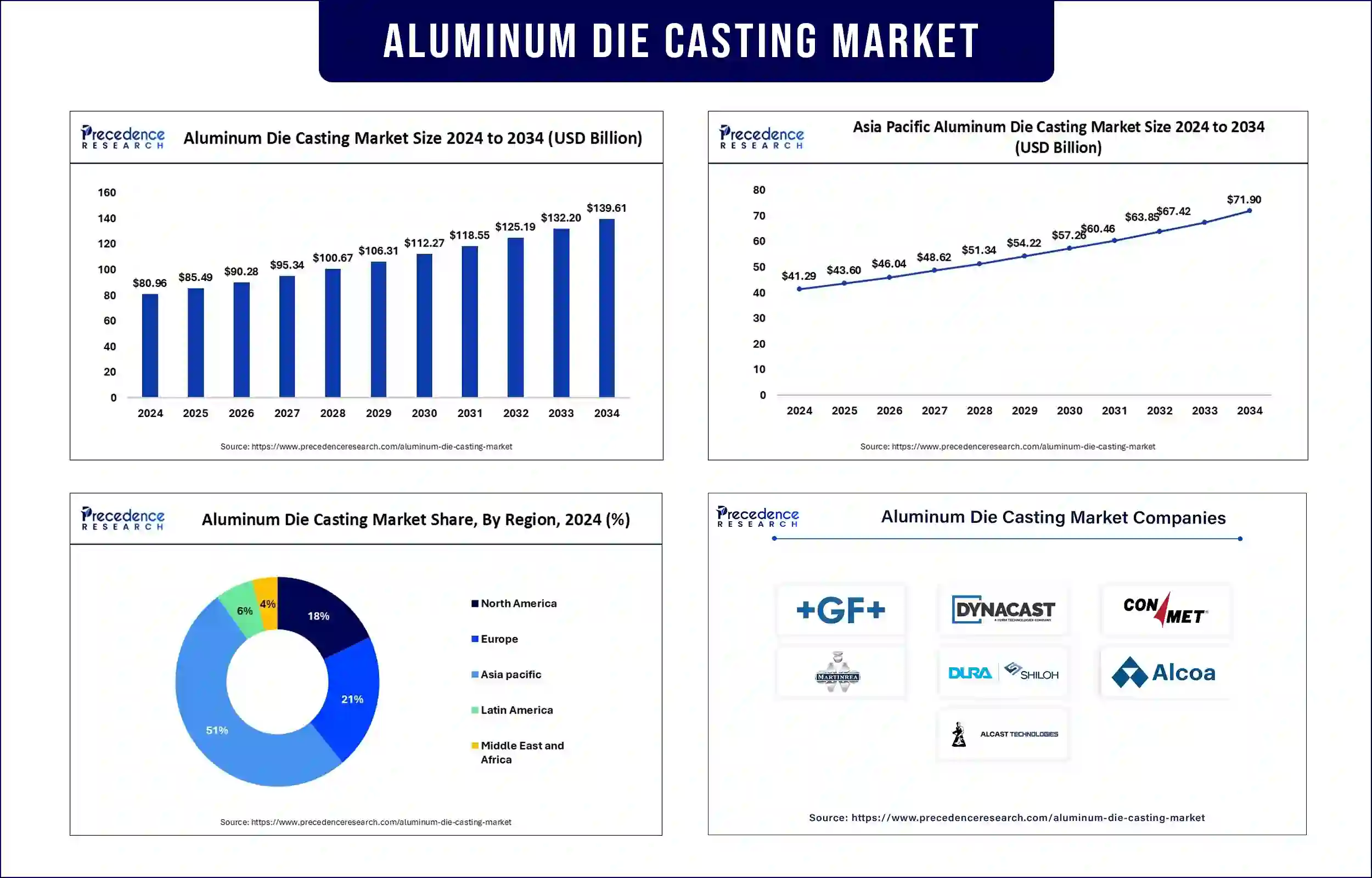December 2024
The global aluminum die casting market revenue reached USD 85.49 billion in 2025 and is predicted to attain around USD 132.20 billion by 2033 with a CAGR of 5.6%. This market is driven by the increasing demand for durable, corrosion-resistant components that enhance fuel efficiency and structural integrity.

Lightweight, durable metal components that serve various industries, from automotive to aerospace to electronics to industrial manufacturing, emerge from the essential aluminum die casting market. This market attracts customers, as customers need durable corrosion-resistant components that improve structural performance and fuel efficiency. Technological progress in exact casting, along with automated systems and sustainable materials, now controls how the industry develops.
The automotive industry is adopting aluminum die casting at an increasing rate due to the EV movement and binding emission standards. Industrial safety remains crucial for the U.S. Food and Drug Administration (FDA) to maintain active oversight of metal safety in different industrial applications. The industry currently demonstrates a shift toward implementing safer manufacturing approaches that also focus on performance optimization.
Rising Demand for Lightweight Automotive Components
Automakers are increasingly adopting aluminum die-cast parts to reduce vehicle weight and enhance fuel efficiency, aligning with global sustainability initiatives. The Environmental Protection Agency (EPA) published its 2023 Automotive Trends Report to show how innovative factory methods helped the automotive industry improve fuel economy along with reducing greenhouse gas emissions. The automotive industry shows commitment to advanced technological adoption. Specifically aluminum die casting, for meeting environmental standards and consumer requirements for eco-friendly vehicles.
Advancements in High-Performance Alloys
Manufacturers are developing new aluminum alloys with improved strength, heat resistance, and corrosion protection, expanding applications in the aerospace and industrial sectors. The agency NASA highlighted in 2023 the vital importance of aluminum-lithium alloys with enhanced capabilities for building spacecraft structures.
High-performance materials deliver exceptional performance at extremely high or low temperatures while remaining lightweight. The European Space Agency (ESA) provides investments toward developing cutting-edge aluminum alloys for space satellite infrastructure to maintain structural integrity throughout harsh space conditions. Key industries increasingly need aluminum alloys that perform at high levels.
Expansion of Smart Manufacturing Technologies
The integration of Industry 4.0 solutions, such as AI-driven process optimization and real-time monitoring, is improving production efficiency and minimizing defects in die-casting operations. Traditional manufacturing is undergoing a transformation as these technological advancements lead to more efficient methods of aluminum die casting that also promote sustainability.
The European Commission’s Industry 5.0 initiative established robotics and machine learning as key elements to optimize die-casting workflows while achieving precision along with material conservation in 2024. The U.S. Department of Energy (DOE) in 2024 provides funding for smart foundries implementing real-time quality control systems that decrease waste and cut down energy usage. The German Fraunhofer Institute works on creating digital twin software for die-casting operations that uses virtual simulations to enhance production parameters before actual implementation.
Increased Adoption of Renewable Energy Infrastructure
The growing worldwide investments in renewable energy fuel the rapid expansion of aluminum die-cast components used within wind turbines, solar panel mounting systems, and energy storage solutions. The European Green Deal hastened solar panel frame and mounting structure manufacturers to use aluminum components, thus supporting the area's carbon neutrality goals. The International Energy Agency (IEA) emphasizes that aluminum helps offshore wind farms operate more efficiently through the weight reduction of turbines and aerodynamic optimization. Renewable energy projects worldwide are expected to boost the need for advanced aluminum die-cast components.
Asia Pacific dominates the global aluminum die casting market, owing to rapid industrialization, coupled with increased automotive production in China, India, and Japan. China generated 31 million vehicle units throughout 2023, which confirmed its position as the top automotive producer on the planet. The rapid expansion of vehicle production causes an increase in the market need for aluminum die-cast components because of their combination of durability and lightweight properties.
The International Energy Agency (IEA) confirms that lightweight materials offer superior fuel efficiency, which supports global sustainability efforts. The World Health Organization (WHO) has spotlighted vehicle emission reduction due to lightweight materials while simultaneously encouraging more manufacturers to use aluminum in their manufacturing operations. The sustained growth of the automotive market in this region exists, as aluminum die casting both sustains the industry expansion and promotes environmental sustainability.
North America is anticipated to experience the fastest growth in the aluminum die casting market due to the rising demand for lightweight materials in the automotive and aerospace industries, along with the presence of advanced manufacturing facilities. Raising fuel economy and decreasing emissions in transportation systems depends heavily on lightweight aluminum parts, as the U.S. Department of Energy (DOE) points out.
The Federal Aviation Administration (FAA) indicates rising dependence on advanced aluminum alloys for aircraft production, which enhances both safety aspects and energy efficiency. Wind energy infrastructure components that employ aluminum die casting receive priority from the National Renewable Energy Laboratory (NREL) since they support regional sustainability objectives.
Major automobile manufacturers operating in U.S. and Canadian markets are strengthening their investments in die-casting technologies to boost product performance and cost savings and meet stricter fuel consumption requirements. North America continues its aluminum die-casting advancement through Industry 4.0 implementation that brings AI-powered defect detection systems and automated process optimization technology.
| Report Attribute | Key Statistics |
| Market Revenue in 2025 | USD 85.49 Billion |
| Market Revenue by 2033 | USD 132.20 Billion |
| CAGR | 5.6% |
| Quantitative Units | Revenue in USD million/billion, Volume in units |
| Largest Market | North America |
| Base Year | 2024 |
| Regions Covered | North America, Europe, Asia-Pacific, Latin America, and Middle East & Africa |
By Production Process
By Application
Get this report to explore global market size, share, CAGR, and trends, featuring detailed segmental analysis and an insightful competitive landscape
overview @ https://www.precedenceresearch.com/sample/1459
You can place an order or ask any questions, please feel free to contact at sales@precedenceresearch.com|+1 804 441 9344
December 2024
January 2025
April 2025
January 2025